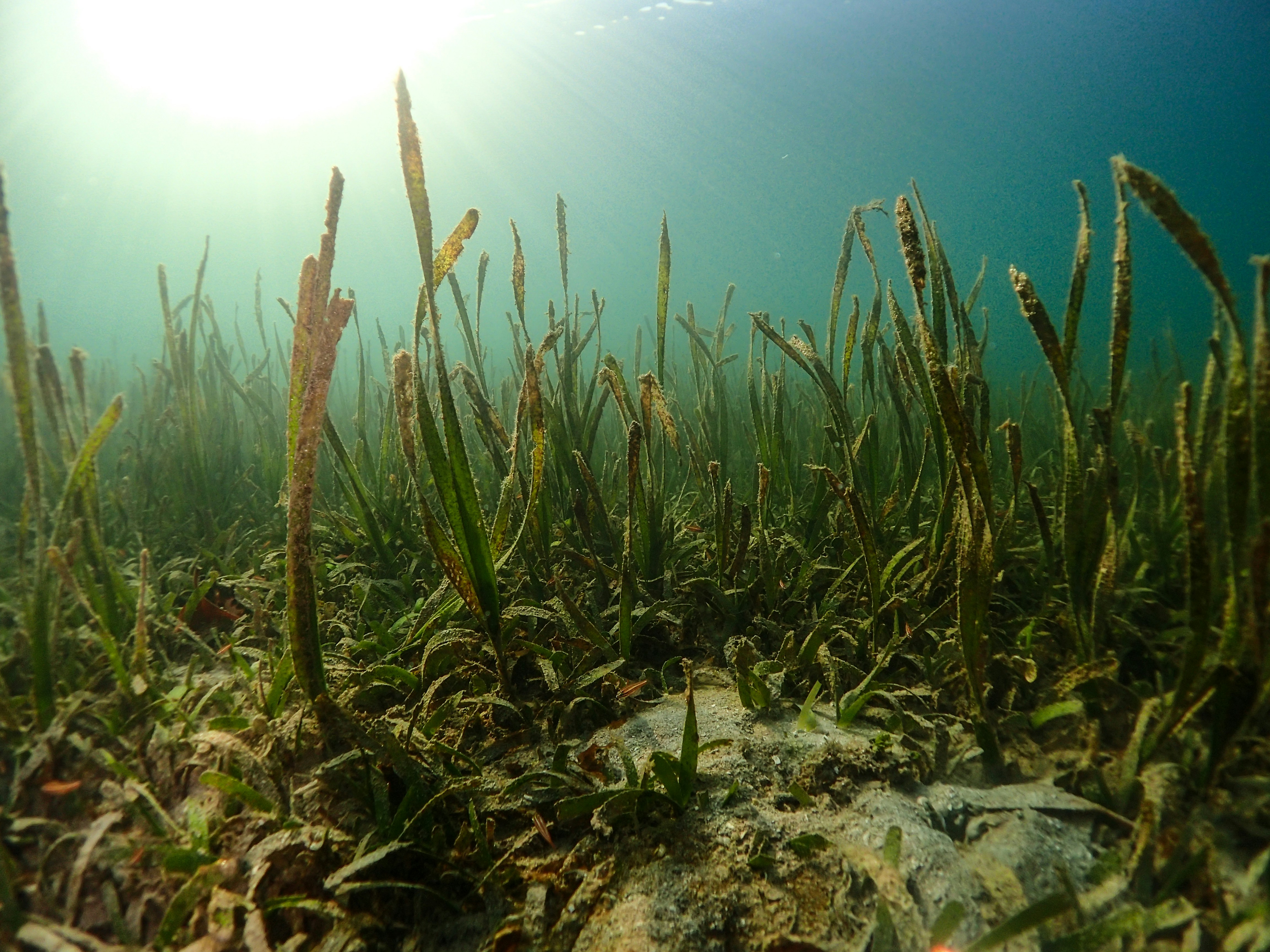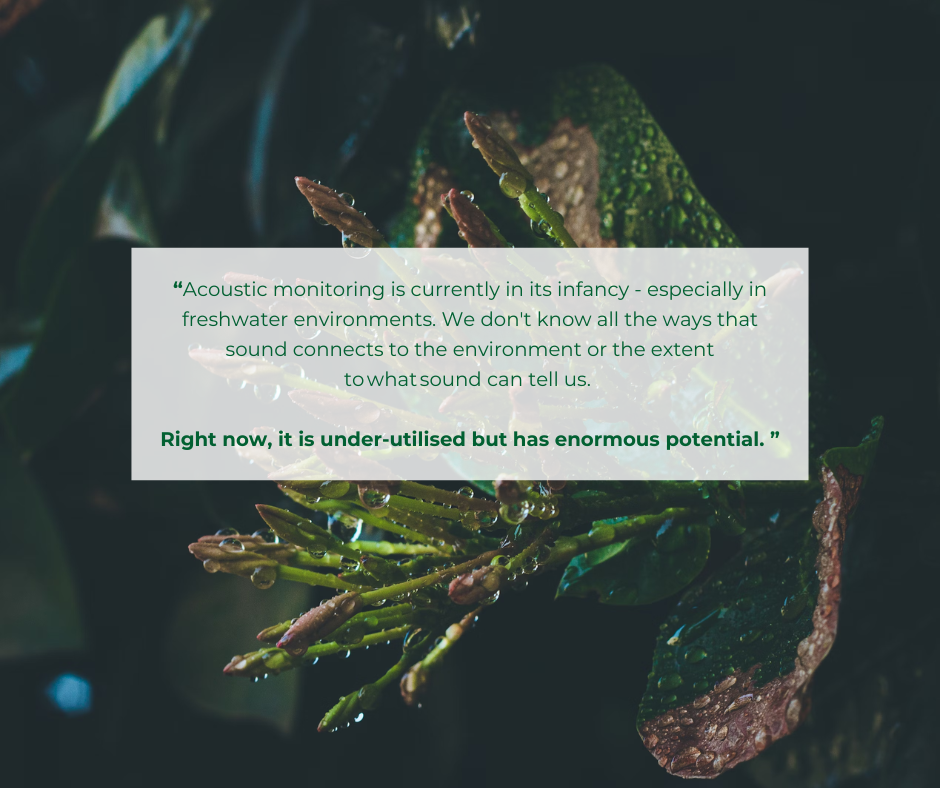Are you listening? Investigating River health and ecology through sound

Image: Jones B. Unsplash.
Future Earth Australia is pleased to profile the awarded Early Career Researchers and Professionals of its inaugural Opportunities Fund – Seizing Opportunities Grant.
This profile interviews Katie Turlington, a PhD student at the Australian Rivers Institute, Griffith University.
Katie is one of 15 recipients of the 2023-2024 Seizing Opportunities Grant.
__
Congratulations on receiving a Seizing Opportunities grant! Can you tell us about your research and the project the grant will support?
In collaboration with my colleague Colin Burke, (Australian Rivers Institute – Griffith University), this research project investigates how soundscapes change in response to restored aquatic plant habitats along the Mid-Brisbane River. This focusses on macrophyte restoration, aquatic plants that live in or near water that provide critical habitat for animals.
You can think of a 'soundscape' as the acoustic component of the landscape - instead of using visual survey techniques to assess the environment, we collect information by listening.
Colin's research focuses on improving spawning habitat for the critically endangered Australian Lungfish (Neoceratodus forsteri) in the Upper and Mid-Brisbane River. My research explores how sound connects to ecological health in freshwater streams, and how we can optimise passive acoustic monitoring to monitor ecosystems holistically, rather than only listening to biological sounds.
We were monitoring Colin's restoration plots for macrophyte growth one day, and I noticed a variety of fauna, such as fork-tailed catfish, that also returned to the area, seemingly benefitting from the restoration. Secondary benefits of macrophyte restoration were occurring here.
I remember saying, “I wonder how noisy this plot is now there is sufficient habitat here compared to when it was bare”, and that was it – we had to find out.
Our collaborators are restoring critical aquatic macrophyte habitat in the river which has been destroyed by intense flooding and is slow to recover. This provided us with the opportunity to assess the impacts of this restoration on the underwater soundscape. We are investigating two concepts. First, are underwater sounds changing as macrophyte cover increases (i.e., are species coming or going as the habitat improves?) and second, could we use sound to monitor these restoration efforts remotely?
What does a typical fieldwork day look like?
A typical day in the field involves driving to multiple sites along the Mid-Brisbane River to deploy small acoustic recording devices. We submerge the devices inside the exclosure plots (where the macrophytes are being restored) and outside the plots (where there is limited vegetation). We leave the recorders to collect information for 24 hours before returning to collect them. We take the data back to the lab to assess the complexity and diversity of sounds.
While in the field, we conduct rapid surveys to determine how macrophyte percent cover changes over time in relationship with environmental factors (i.e., water depth and flow velocity). By combining these critical components, we can identify how the soundscape changes as a response to macrophyte restoration efforts.
The Seizing Opportunities Grant has supported the purchase of seven acoustic recording devices for this research project.

Quote: Katie Turlington
How does river life communicate via sound? What sorts of things do sounds tell us about the health of a river ecosystem?
Soundscapes serve as an important communication medium for biota. Like birds singing in a forest or frogs croaking after rain, underwater life can be lively too - we just don't hang out underwater enough to hear it! Underwater sounds transfer information between animals (like when we speak), ranging from terrestrial disputes to mating calls, predator-prey interactions, or food availability.
In many acoustic surveys, sound is used to assess the biodiversity in an area. Similar to conducting visual surveys in traditional ecology, we can use sound to survey ecological communities.
My research takes a unique approach, as I'm interested in how sound connects to the environment by looking at variables like vegetation and water quality.
By understanding how sound relates to these variables, we could use sound as an indicator to monitor environmental parameters that do not inherently create sound (like macrophyte cover). This will also help to better understand ecosystem dynamics and allow us to create more holistic acoustic monitoring programs.
Biological sounds aren't the only sounds we hear underwater, either. We can also hear and assess geological processes like water flow, sediment movement and human activities like boating or construction. By monitoring all sounds in an ecosystem, we develop a more comprehensive view of the ecosystem, ecological interactions, and ecological health.
In what way is the use of acoustic recording technology new or innovative for this kind of work? What might this technique allow us to do in the future? Could it be applied to other ecosystems or marine environments?
Acoustic monitoring in freshwater ecosystems is understudied compared to work done in terrestrial and marine environments. Traditionally, ecological monitoring in rivers has heavily relied on visual survey methods, which are often labour-intensive, time-consuming, and can be limited by factors like turbidity and accessibility. Acoustic monitoring offers a passive monitoring approach to surveying these ecosystems that requires less in-field effort; it also allows us to uncover patterns and relationships that may not be evident using visual methods alone.
In past research, sound has been used to assess life in freshwater systems, but it has not yet been sufficiently tested whether sound can provide insights into other environmental parameters - like changes in macrophyte extent. By identifying whether we can hear changes in the soundscape as macrophyte cover changes, we may be able to use sound to monitor macrophyte restoration activities in the future.
This could revolutionise how we monitor and assess the health of aquatic ecosystems, providing a non-invasive and cost-effective method that complements traditional visual survey methods.
What are the challenges of doing this sort of monitoring and fieldwork?
One of the biggest challenges we face in acoustic monitoring is managing and analysing the vast data we collect in our surveys. A trained technician can take around three minutes to assess one minute of acoustic recordings manually. As you can imagine, if we collect 24-hour recordings across multiple sites and sampling occasions, we will quickly collect an extensive dataset. We are currently investigating unsupervised learning techniques to identify underwater sounds and help reduce processing and analysis time, and there are many talented researchers developing automated sound analysis processes to overcome these challenges.
What do you enjoy most about this research? What do you find most interesting?
The aspect I enjoy the most about acoustic research is that it is a non-invasive method where we can remotely monitor ecological communities while having minimal impact on the ecosystem and its inhabitants.
By using sound to monitor these ecosystems, we can collect more data with less time, labour, costs, and environmental disturbances - which will become increasingly important as we face further ecological and climate change challenges. Unlocking and optimising the potential of acoustic monitoring will allow us to better monitor and manage our ecosystems efficiently and ethically.
__
Future Earth Australia thanks Katie Turlington for this wonderful interview and looks forward to supporting her aquatic research and beyond.
The Opportunities Fund would not be possible without the support of Granders Trust.
Find out more here.